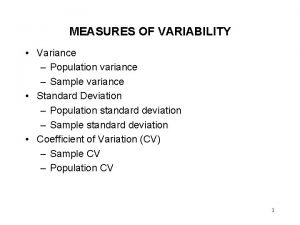Analysis of Variance and Design of Experiments Math











- Slides: 11

Analysis of Variance and Design of Experiments (Math 446/546) January 27, 2014

Two Types of Studies 1. 2. Observational Study – The researcher observes individuals and measures variables of interest but does not attempt to influence the responses. (Establishes Association) Experimental Study – The researcher deliberately imposes some treatment on individuals in order to observe their responses. (Establishes Cause-and-effect)

Examples of Experimental Studies Example 1 : Consider the problem of comparing the effectiveness of 3 kinds of diets (A, B, C). Forty males and 80 females were included in the study and were randomly divided into 3 groups of 40 people each. Then a different diet is assigned to each group. The body weights of these 120 people were measured before and after the study period of 8 weeks and the differences were computed. Example 2 : In a classic study, described by F. Yates in the The Design and Analysis of Factorial Experiments, the effect on oat yield was compared for three different varieties of oats (A, B, C) and four different concentrations of manure (0, 0. 2, 0. 4, and 0. 6 cwt per acre).

Terminologies Ø Ø Ø Experimental Units – These are the individuals on which the experiment is done. {patients} Ø Subjects – human beings. Response variables – Measurement of interest. {blood pressure, no. of days to full recovery, etc. } Factors – Things that might affect the response variable (explanatory variables). {new drug} Levels of a factor – The different forms of a factor. {no drug, 10 mg, 25 mg, etc. } Treatment – A combination of levels of factors.

Example 1 : Diet Study Example 1 : Consider the problem of comparing the effectiveness of 3 kinds of diets (A, B, C). Forty males and 80 females were included in the study and were randomly divided into 3 groups of 40 people each. Then a different diet is assigned to each group. The body weights of these 120 people were measured before and after the study period of 8 weeks and the differences were computed. a) Experimental units : b) Response variable : c) Factor(s) : d) Levels : e) Treatments :

Example 2 : Oat Yield Study Example 2 : In a classic study, described by F. Yates in the The Design and Analysis of Factorial Experiments, the effect on oat yield was compared for three different varieties of oats (A, B, C) and four different concentrations of manure (0, 0. 2, 0. 4, and 0. 6 cwt per acre). a) Experimental units : b) Response variable : c) Factor(s) : d) Levels : e) Treatments :

More Examples Example 3 : The administration of a college of business offered its faculty the opportunity to participate in a summer workshop, but were asked to sign up on a first-come, first-served basis. Of the 110 faculty in the business school, 63 faculty elected to attend the seminar. At the end of the following year, the administration compared the recent teaching performance of faculty who attended the seminar to those who did not attend. Students evaluated on a 7 -point scale, where 1 indicates poor performance and 7 is outstanding. Example 4 : An appliance manufacturer operates three regional training centers in the United States for training mechanics to service the company’s products. At each regional center, two different training programs were studied, with the trainees from the region assigned at random to one of the two training programs.

Comparative Studies n n In a comparative experimental study, randomization is employed to assign a set of treatments to the experimental units, and the observed outcomes among the treatments groups are compared to assess treatment effects. Cause-and -effect relationships between the experimental factors and the response variable can be established with this kind of study. In a comparative observational study, random samples are obtained from two or more populations (or subpopulations) and the observed outcomes among the treatments groups are compared across populations (or subpopulations). A cause-and-effect relationship between the explanatory factors and the response variable is difficult to establish in an observational study.

Design of an Experiment The design of an experiment refers to the structure of the experiment, with particular reference to: Ø Ø Ø The set of explanatory factors included in the study. The set of treatments included in the study. The set of experimental units included in the study. The rules and procedures by which the treatments are randomly assigned to the experimental units (or vice versa) The outcome measurements that are made on the experimental units.

Designs of Experiments Ø Ø Ø Completely Randomized – Experimental units are allocated at random among all treatments, or independent random samples are selected for each treatment. Ø Double-Blind Study – Neither the subjects nor the medical personnel know which treatment is being giving to the subject. Matched Pair – Used for studies with 2 treatment arms, where an individual from one group is matched to another in the other group. Block Design – The random assignment of units to treatments is carried out separately within each block. Ø Block – is a group of experimental units that are known to be similar in some way that is expected to affect the response to the treatment.

Example 1 : Diet Study Example 1 : Consider the problem of comparing the effectiveness of 3 kinds of diets (A, B, C). Forty males and 80 females were included in the study and were randomly divided into 3 groups of 40 people each. Then a different diet is assigned to each group. The body weights of these 120 people were measured before and after the study period of 8 weeks and the differences were computed. Ø Block - Gender





















